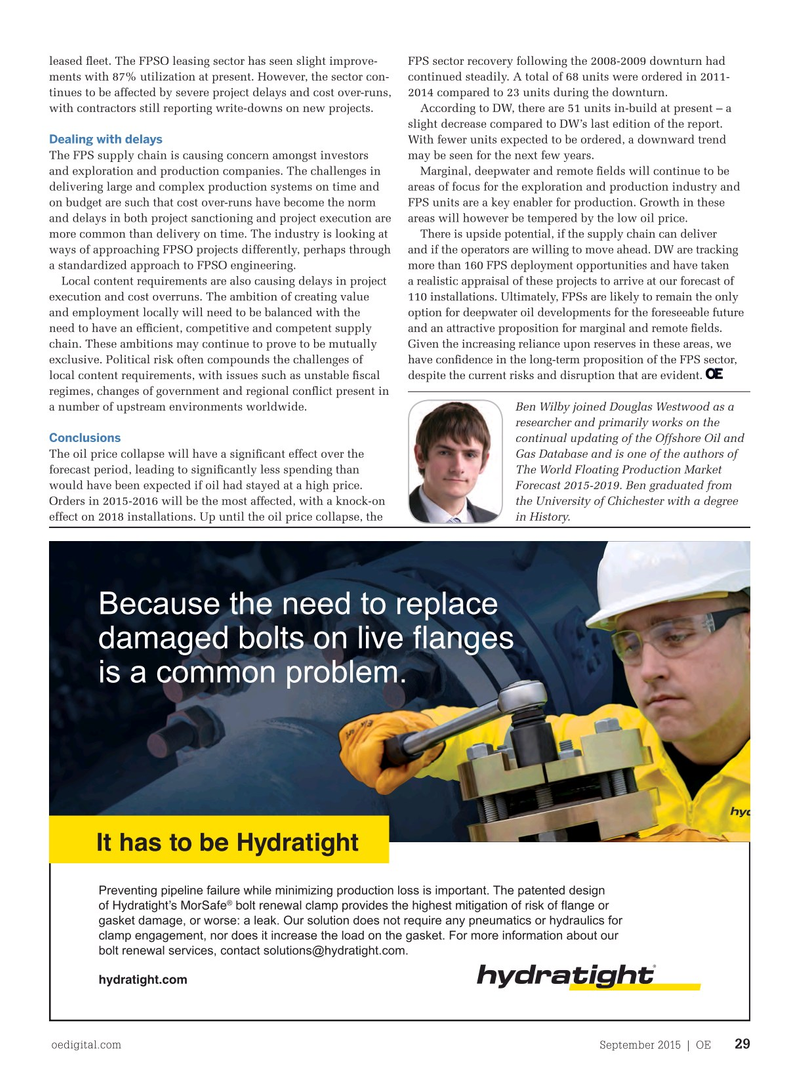
Page 27: of Offshore Engineer Magazine (Sep/Oct 2015)
Read this page in Pdf, Flash or Html5 edition of Sep/Oct 2015 Offshore Engineer Magazine
leased feet. The FPSO leasing sector has seen slight improve- FPS sector recovery following the 2008-2009 downturn had ments with 87% utilization at present. However, the sector con- continued steadily. A total of 68 units were ordered in 2011- tinues to be affected by severe project delays and cost over-runs, 2014 compared to 23 units during the downturn.
with contractors still reporting write-downs on new projects. According to DW, there are 51 units in-build at present – a slight decrease compared to DW’s last edition of the report.
Dealing with delays
With fewer units expected to be ordered, a downward trend
The FPS supply chain is causing concern amongst investors may be seen for the next few years. and exploration and production companies. The challenges in Marginal, deepwater and remote felds will continue to be delivering large and complex production systems on time and areas of focus for the exploration and production industry and on budget are such that cost over-runs have become the norm FPS units are a key enabler for production. Growth in these and delays in both project sanctioning and project execution are areas will however be tempered by the low oil price. more common than delivery on time. The industry is looking at There is upside potential, if the supply chain can deliver ways of approaching FPSO projects differently, perhaps through and if the operators are willing to move ahead. DW are tracking a standardized approach to FPSO engineering. more than 160 FPS deployment opportunities and have taken
Local content requirements are also causing delays in project a realistic appraisal of these projects to arrive at our forecast of execution and cost overruns. The ambition of creating value 110 installations. Ultimately, FPSs are likely to remain the only company budgets and greater efforts are being made to ensure and employment locally will need to be balanced with the option for deepwater oil developments for the foreseeable future delays and cost over-runs are avoided to maintain project eco- need to have an effcient, competitive and competent supply and an attractive proposition for marginal and remote felds. nomics. At the same time local content requirements are push- chain. These ambitions may continue to prove to be mutually Given the increasing reliance upon reserves in these areas, we ing up prices and extending lead times, particularly in Brazil. exclusive. Political risk often compounds the challenges of have confdence in the long-term proposition of the FPS sector,
For the oil company feld operator, FPS ownership becomes local content requirements, with issues such as unstable fscal despite the current risks and disruption that are evident. the more cost-effective option where production extends over a regimes, changes of government and regional confict present in long period. However, given the current macroeconomic envi- a number of upstream environments worldwide. Ben Wilby joined Douglas Westwood as a ronment, such capex commitments may be deferred. Therefore, researcher and primarily works on the
Conclusions the decision to lease an FPS can be seen as a trade-off between continual updating of the Offshore Oil and the lower upfront capex and the increased operational expen- The oil price collapse will have a signifcant effect over the Gas Database and is one of the authors of ditures as a result of the leasing charges. However, leasing also forecast period, leading to signifcantly less spending than The World Floating Production Market brings advantages in terms of the cost of feld abandonment. would have been expected if oil had stayed at a high price. Forecast 2015-2019. Ben graduated from
The top three leasing contractors are SBM Offshore, MODEC Orders in 2015-2016 will be the most affected, with a knock-on the University of Chichester with a degree and BW Offshore, which collectively account for 35% of the effect on 2018 installations. Up until the oil price collapse, the in History.
Because the need to replace damaged bolts on live fanges is a common problem.
Preventing pipeline failure while minimizing production loss is important. The patented design ® of Hydratight’s MorSafe bolt renewal clamp provides the highest mitigation of risk of fange or gasket damage, or worse: a leak. Our solution does not require any pneumatics or hydraulics for clamp engagement, nor does it increase the load on the gasket. For more information about our bolt renewal services, contact [email protected].
hydratight.com oedigital.com September 2015 | OE 29 026_OE0915_Feat1_DouglasWestwood.indd 29 8/19/15 9:08 PM

 26
26

 28
28